D&D playstyles and character dynamic featured image is from Explorer’s Guide to Wildemount. This article contains affiliate links to put gold in our coffers.
You D&D and TTRPG players can identify your playstyles, so you know what to look for in a game. Your playstyle dynamic describes how your character will interact with the shared fictional world of a tabletop roleplaying game outside of combat, called the Interaction and Exploration pillars-of-play in Dungeons & Dragons.
It’s important to note that your Dynamic doesn’t dictate how you’re supposed to roleplay your character. Instead, it’s a summary of how specific skills and features aid characters in achieving certain non-combative goals in the game. Your dynamic should serve as a guide for how you improvise your character’s interactions, and these dynamics can blend to make characters with even more roleplay depth! A tinkering artificer might serve as the party’s Dungeoneer and Supplier; a pretty boy gladiator might be the Face and the Muscle; and the group’s Navigator could also be its Keeper, guiding the group through the wilderness and treating their wounds after a rough encounter.
In this article, I’m going through each of these dynamics and detailing some examples from fiction. I’ll include what classes give you proficiencies or features that contribute to that playstyle aspect. I’ll share my recommended class for each playstyle and an option that surprised me. Backgrounds can also contribute to your dynamic, but I won’t be getting into them here because of the codified “build-a-background” rules.
Regarding features like Expertise and Jack-of-all-Trades, I’m only considering them if the class gains proficiency with skills relating to the playstyle, and the class’s primary combat ability synergizes with those skills. Otherwise, Bard and Rogue are going to dominate every single dynamic.
— The Brain
— The Dungeoneer
— The Face
— The Keeper
— The Muscle
— The Navigator
— The Scout
— The Sneak
— The Supplier
Also, be encouraged to develop dynamics other than what I listed here! These will be more traditional examples, but if you can come up with more, leave them in the comments! I’m just a fantasy and TTRPG enthusiast at the end of the day, and the last thing I want to do is make you feel “boxed in” by an explanation. Think of my analytical style the same way Aristotle wrote his Metaphysics: I try to define ideas to understand better and explain them, not to reduce the “beauty” or “essence” of the concept. These are fun topics to discuss, so let’s get into dynamics with the Brain.
“The Brain” Playstyle
The Brain, or the Mind as I’ve also seen it called, is the group researcher. These characters search through occult tomes, history books, and religious texts for any hint of lore. In D&D, these all tend to fall under the same scope as far as a Brain dynamic goes, but in pop culture, we see two types of Brains presented: what I’ll call here the Arcanist and the Scribe. Both offer comparable levels of intellectual prowess but focus on different fields.
The best example of this contrast is the relationship between Dr. Orpheus and Dr. Venture of the Venture Brothers. I will reference this show again later because this show is amazing at fleshing out character personas. Orpheus is the resident necromancer and Dr. Strange cosplayer at the Venture Compound, and Venture is a scientist long past his prime. Instead of putting Dr. Venture in the overdone “religion versus science” scenario, Orpheus acts as Venture’s Lancer in a friendly rivalry of “magic versus science.” This is banter I would have loved out of an Artificer and Wizard pair at a D&D table and why I’m pretty behind a Scholar, Inventor, or Engineer class.
Getting back to the Brain; whatever the flavor, this is the character doing a majority of the Intelligence checks, holding up in the library, doing any necessary transcribing of ancient books, and sure to be played by Benedict Cumberbatch in the movie adaptation of your story.
Famous “Brain” Examples
- Caleb Widogast (Critical Role)
- Data (Star Trek)
- Donatello (Teenage Mutant Ninja Turtles)
- Hermione Granger (Harry Potter)
- Gandalf (Lord of the Rings)
- Jim Darkmagic (Acquisitions Inc.)
- Rick Sanchez (Rick & Morty)
- Rusty Venture & Thadeus Orpheus (The Venture Bros)
- Stephen Strange (Doctor Strange)
- Sherlock Holmes
- Sypha (Castlevania)
- The Doctor (Doctor Who)
- Walter White (Breaking Bad)
- Velma (Scooby Doo)
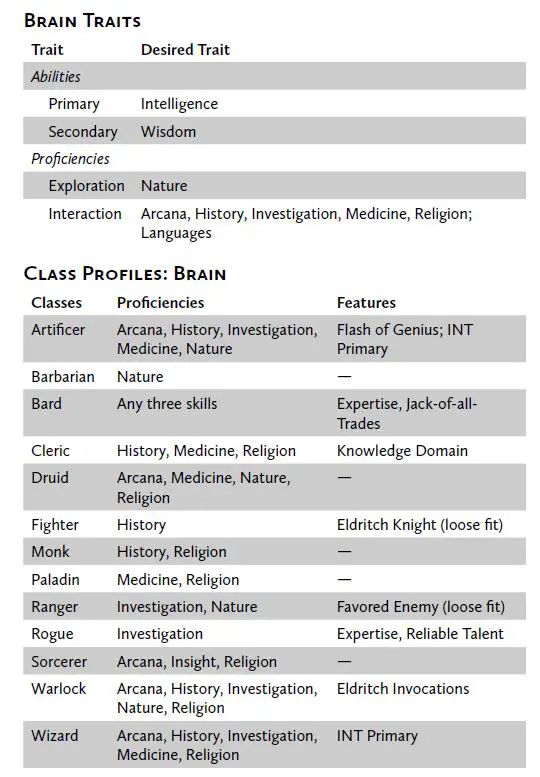
Recommended Class for “The Brain”: Artificer
It feels a bit unfair because the Artificer’s base class came late into 5e and the general power budget of the class is much higher than most of the other base classes. The Wizard relies on spells to help their ability checks and therein has versatility available; but thanks to this feature, Artificer doesn’t have to invest into Spells Known to Brain. Wizard has no problem being the party Brain and likely would have been my choice for the Ideal Class to build a Brain had it not been for Artificer’s Flash of Genius.
Surprise Star: Warlock
Had Warlock been the Intelligence caster so many believe it should be, this would be a clean sweep. You can pick up Eldritch Invocations to aid just about every Dynamic, but Warlock gets access to possibly the strongest roleplay feature for this dynamic: Eyes of the Runekeeper. This feature basically has no uses in combat, but being able to instantly translate any writing has so much potential for defining your character. If you want to consider this a ribbon, it’s my vote for the most vital ribbon feature currently in the game.
“The Dungeoneer” Playstyle
The Dungeoneer is a dynamic focused on overcoming the common challenges of dungeons. Seeing as “Dungeons” makes up half the name of this game, the Dungeoneer is a valuable dynamic in the party.
Dungeoneers need to come equipped with abilities that help detect traps and tools to disarm them. A scythe trap doesn’t care about your nat20 Persuasion check, it will swing no matter how correct you are. For this, the Dungeoneer favors the Perception and Investigation skills and proficiency with thieves’ tools for disarming. I allow tinker’s tools to do this, but that isn’t codified in the rules. It also helps if Dexterity is the class’s Strong Saving Throw Proficiency, as it tends to be the most common saving throw against triggered traps.
Bonus points if you can get proficiency with Arcana checks or the dispel magic spell, as both can add a lot to this dynamic interacting with magical traps. If you can get proficiency with Constitution saving throws, you won’t have to fear those traps that try to poison you instead of stab you.
Famous “Dungeoneer” Examples
- Angus MacGyver (MacGyver)
- Batman (DC)
- Dr. Henry Walton “Indiana” Jones (Indiana Jones)
- Lara Croft (Tomb Raider)
- Link (The Legend of Zelda)
- Nathan Drake (Uncharted)
- Nott the Brave (Critical Role)
- R2D2 (Star Wars)
- Rick Sanchez (Rick & Morty)
- Sombra (Overwatch)
- Tony Stark (Marvel)
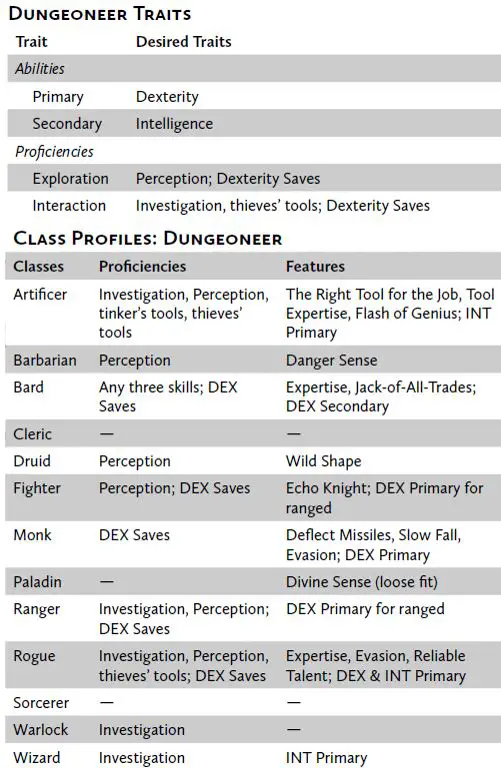
Recommended Class for “The Dungeoneer”: Rogue
The Rogue is straight-up built for dungeoneering. Part of why the Thief might be a bit underwhelming as the “archetypal dungeoneer” of this edition is that so much of the subclass’s dynamic spreads across the base class.
I hear people say the rogue’s only job is to “Sneak Attack,” but the party rogue has the features needed to ensure you even get to the BBEG before setting off every dart trap and pressure plate in the dungeon. Wizards of the Coast did everything they could to reinforce this outside of making a 10-foot pole standard equipment on the Rogue.
Surprise Star: Artificer
Artificers exist as an interesting rogue-wizard hybrid with access to a spell list that includes mage hand, identify, and dispel magic. Essentially, the Rogue is the dexterous Dungeoneer, and the Artificer is the intellectual. Both classes have a great level progression for this dynamic; they do so differently. The tools expert makes a fantastic trap breaker.
“The Face” Playstyle
Due to the memes, the Face is likely the most well-known dynamic. While typically portrayed as the “horny character,” the Face’s real strength is helping to progress the story through social interactions. There are some fights you can’t win through brute force, but you might be able to talk your way out of it.
The Face can be a scoundrel that focuses on subterfuge, a diplomat of renowned honor, and even the horndog that thinks seduction is an actual skill check. If you’re considering playing a face, you should be required to watch “The Road to El Dorado.” The movie is the D&D adventure of a Rogue and a Bard competing for the spot as the party Face.
However, what makes a good face isn’t just the ability to talk oneself into or out of a situation; it’s also in detecting deceit. Insight checks are precious to the Face and the ability to determine if the other party is being forthright in their identity. The Face is also keen on Wisdom saves, as those are the most common saves made against the charmed condition, the most common condition to come up with social interaction. Shapeshifters tend to be social creatures, and your party Face will never forget such an encounter.
Famous “Face” Examples
- Breeze (Mistborn)
- Dandelion (The Witcher)
- Faye Valentine (Cowboy Bebop)
- C3PO & Han Solo (Star Wars)
- Locke Lamora (The Gentleman Bastards Sequence)
- Miguel & Tulio (The Road to El Dorado)
- Molly Carpenter (Dresden Files)
- Nightwing (DC)
- Scanlan Shorthalt (Critical Role)
- Timothy Goodboy “Viari” Dunstucker (Acquisitions Inc.)
- Tyrion Lannister (Game of Thrones)
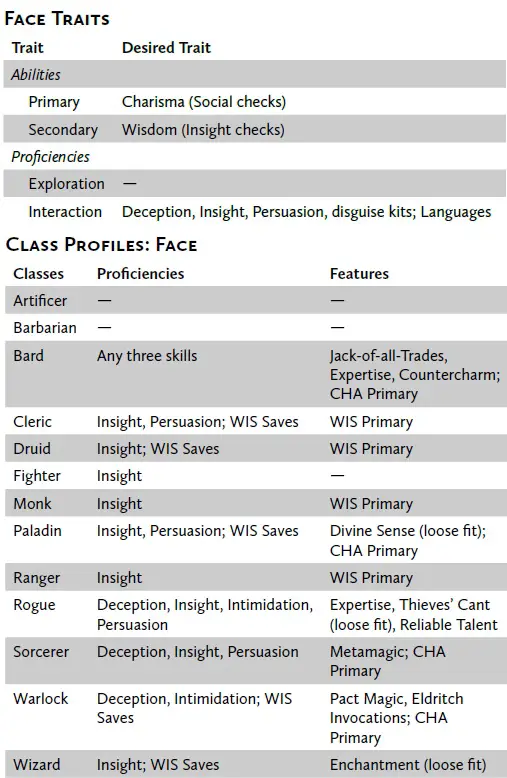
Recommended Class for “The Face”: Bard
Bard has a different version of Expertise from the Rogue, wherein it only applies to skill checks instead of skill and tools checks. In combination with Jack-of-all-Trades, most players will double their proficiency in the skills they can already see their character doing well with, making Bard’s Charisma-based spellcasting and social synergy look highly appealing. Despite its flaws, Countercharm is there, which helps compensate for Bard’s lack of Wisdom saving throw proficiency.
Surprise Star: Warlock
While the Rogue is a skill-monkey, nothing other than skill checks synergizes with Charisma investment unless you go Swashbuckler. However, Warlock possibly gets the most out-of-combat-friendly form of spellcasting thanks to the short rest refresh of Pact Magic, using Charisma as its spellcasting ability.
Additionally, several of the Eldritch Invocations allow for things like at will disguise self with Mask of Many Faces and the ability to read all writing with Eyes of the Rune Keeper. Hell, even the Great Old One (despite its many flaws) gains telepathic speech to any creature within 30 feet of it. Warlock brings a pretty dark flair to the Face dynamic, really only left wanting for a form of Expertise in these social skills.
“The Keeper” Playstyle
If you like the body part naming convention I’ve been keeping, you could call the Keeper the “Heart.” Keepers can come in many forms: divine healers, potion brewing apothecaries, remarkable cooks, field surgeons, and even necromancers can fit this dynamic! A Keeper’s dynamic is one of the caretaker. Their role extends outside of healing to bolstering, buffing, and sustaining the party.
There are several options for creating a Keeper in 5e that isn’t strictly tied to divine classes. The Chef feat in Tasha’s Cauldron of Everything makes you the food truck of the Forgotten Realms. The Healer feat allows you to quickly patch up your allies after combat. Using herbalism kits, you can create potions of healing given the downtime.
Roleplay-wise, keepers are the voice of reason in a party. Jake the Dog acts as the Keeper in Adventure Time, not just because the guy can cook but also because he nurtures Finn as a big brother. Jake keeps his relatively calm demeanor in the face of Finn’s childlike antics, meaning while Finn has the habit of putting himself in harm’s way, Jake’s misfortune is primarily due to miscalculations or the fault of others. While personality and behavior are flexible, one thing doesn’t change: the Keeper always looks out for others.
Seeing as there are Feats that can evoke this dynamic, we’re going to look specifically at the provided proficiencies and class features that can help evoke the Keeper feel. Access to healing magic is a big plus, but class features that can do so separately from spell slots will be weighed heavier. Also, from talks I’ve had with other D&D personalities, dungeon masters, and designers, it sounds like just about everyone house rules a character with alchemist’s supplies proficiency and the ability to create potions of healing, so I’ll consider that here as a possible alternative to herbalism kits.
Famous “Keeper” Examples
- Aerith (Final Fantasy VII)
- Caduceus Clay (Critical Role)
- Dende (Dragon Ball Z)
- Fire Keeper (Dark Souls)
- Jake the Dog (Adventure Time)
- Katara (Avatar: The Last Airbender)
- Samwise Gamgie (Lord of the Rings)
- Yuna (Final Fantasy X)
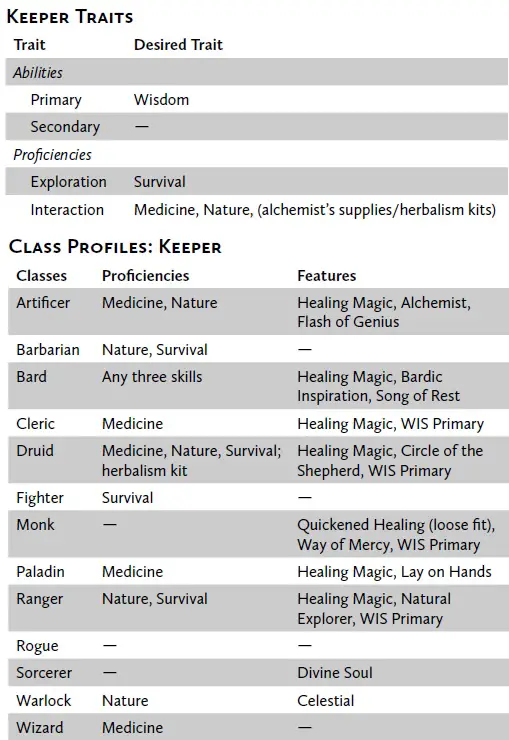
Recommended Class for “The Keeper”: Druid
I would have pictured Cleric in here, but Druid also absolutely makes sense. A spellcasting ability synergizes with Medicine and Survival checks, given 1st-level proficiency with herbalism kits and all the healing magic you’d want from Cleric (if you’re playing post-Tasha’s, that is). The ideal subclass for this is likely Shepherd, but it might be Dreams. Giving Dreams some Circle Spells would go a long way.
Other close contenders are Bard and Alchemist Artificer, likely because Cleric doesn’t get much in the way of these Keeper proficiencies I’ve listed. However, Cleric is likely preferred for this dynamic based on their spellcasting mechanics alone.
Surprise Star: Monk – Way of Mercy
Tasha’s Cauldron of Everything was pretty kind to the Monk, and the Way of Mercy is a terrifyingly good healer. They can use ki to restore hit points equal to a roll of their martial arts die plus their Wisdom modifier. At 11th level, you’re getting eleven uses of a 1st-level Cure Wounds spell every short rest, and it even works with Flurry of Blows! While Bard, Paladin, and Cleric are all excellent Keepers, the Way of Mercy Monk took me by surprise for how well it fit this dynamic.
“The Muscle” Playstyle
Thought Strength was a dump-stat? You’re not entirely wrong, but it isn’t without its uses. While a Dungeoneer or Sneak wants to break into something, the Muscle intends to break down something. There’s nothing wrong with being the strongman of the group. Every party needs its resident battering ram because it doesn’t matter how good your thieves’ tools checks are when it’s a boulder blocking your passage instead of a door.
The Muscle is favored as the intimidator of the group, but you don’t always have to be a bully. It’s more fun to figure out ways to use Athletics and Intimidation checks without pure force. Watch this clip of Brock Sampson pulling a full-alpha Intimidation check after slaughtering a stow-away alligator. Brock didn’t bully that guard; he stood his ground. That can be more than enough to intimidate your enemies.
Also, don’t be under the impression that the Muscle has to be dumb. Big Dumb Guys and Gals can be comedic relief at the table, but it’s a bit of a tired trope. Imagine if Ashley Johnson had played Yasha as a female mirror of Travis Willingham’s Grog. I think fans would have grown tired of the new character within the first ten episodes. Instead, Ashley plays her as a somewhat socially awkward mother figure to the group, making her Muscle dynamic something wholly different from the goliath barbarian of the first campaign. Watching Travis’s reaction whenever Yasha goes into Rage is still hilarious. Muscle respects Muscle.
Famous “Muscle” Examples
- Alex Luis Armstrong (Full Metal Alchemist)
- Brock Sampson (Venture Brothers)
- Chewbacca (Star Wars)
- Finn the Human (Adventure Time)
- Grog Strongjaw (Critical Role)
- Ham (Mistborn)
- Jean Tannen (Gentleman Bastards)
- Superman (DC)
- The Hulk (Marvel)
- Tifa Lockhart (Final Fantasy VII)
- Wulfgar Brynjarsson (Forgotten Realms)
- Yasha Nydoorin (Critical Role)
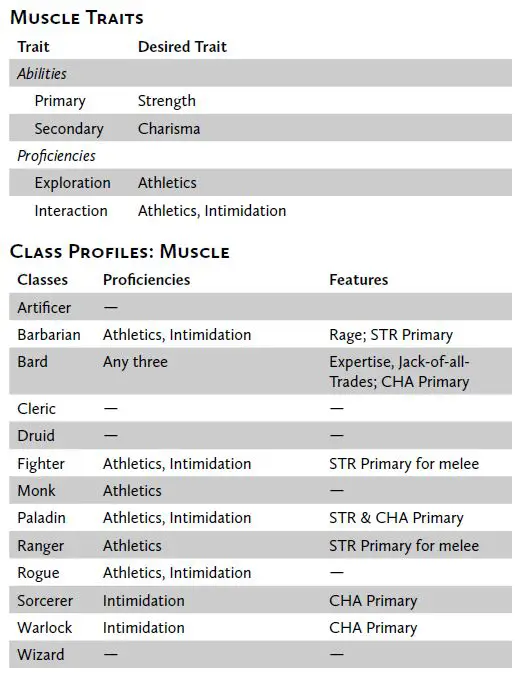
Recommended Class for “The Muscle”: Paladin
The sad story for D&D 5e is that Barbarian doesn’t provide everything you’d want out of this archetype, and the Muscle needs to have some Charisma investment per the vanilla rules. Paladin’s heavy armor proficiency means they’re not incredibly worried about divesting away from Constitution for Charisma, and it also helps with their spellcasting. Besides the proficiencies and primaries, Paladin doesn’t get much outside of spellcasting to assist it in this role, which leaves the Muscle forgotten as far as a base class feature goes.
Rage could be a feature that would push Barbarian over the top for this, but uses restrict it. How often are you going to use Rage outside of combat? Maybe for pretty intense, flavorful roleplay moments, but it’s typically always going to lead towards combat if you do because you’ll lose that Rage use quickly. If there had been an additional condition for Rage to extend if you make a Strength check during your turn? I think Barb would have been sitting real pretty.
If you have a player very intent on playing a Muscle, DMs out there, consider allowing the variant rule for Strength to be used in place of Charisma for Intimidation checks relating to the character’s physical prowess. The tied-in abilities and skills checks of D&D 5e need this kind of flexibility, and it will make your party Muscle feel way more helpful outside of combat.
Surprise Star: Bard
Well… yeah, I guess this is a thing? After all, Intimidation is a Charisma check. It looks like Muscle Bard going Valor or Swords could work! Jack-of-all-Trades lets you focus on Strength a little more, but the build goes against what Bard tries to do. However, you could multiclass Bardbarian, and now we’re talking. Rage for the situational Athletics checks and cast spells that don’t require concentration. Magical Secrets allowing you to grab Armor of Agathys and Shield? This makes me want to roll up a skald barbarian so bad.
“The Navigator” Playstyle
In survival-heavy campaigns, this dynamic is essential. The Navigator will be the character keeping the party from getting lost in the wild, foraging for food, and keeping their eyes out for trouble. The Navigator, Scout, and Sneak all have a focus around the surprise mechanic as well:
- Navigators prevent surprise
- Scouts coordinate surprise
- Sneaks confirm surprise
Survival will be your second priority because this is how you tell where you’re going, if the weather changes, the time of day, forage for food, everything. For this reason, you will want a high Passive Perception, requiring Perception proficiency and investment into Wisdom. Perception also applies to many situations, so you’ll get used to it even when you aren’t out on the road.
After that, it’s your call, but Nature is great for identifying poisonous flora and fungi. Animal Handling is a nice snag for peacefully dealing with random beasts that you might encounter because stumbling into a sleuth of bears is bad news for even higher-level parties (I also just learned that a group of bears is called a “sleuth” and now I can’t stop thinking about a detective grizzly). For tools, cartographer’s tools and vehicles are a no-brainer for this dynamic. A class rarely gives these proficiencies, so check out some of the Backgrounds when you’re building a Navigator!
Famous “Navigator” Examples
- Aragorn (Lord of the Rings)
- Lynceus of Argos (Greek Mythology)
- Nami (One Piece)
- Percy Jackson (Percy Jackson and the Olympians)
- Sokka (Avatar: The Last Airbender)
- The Doctor (Doctor Who)
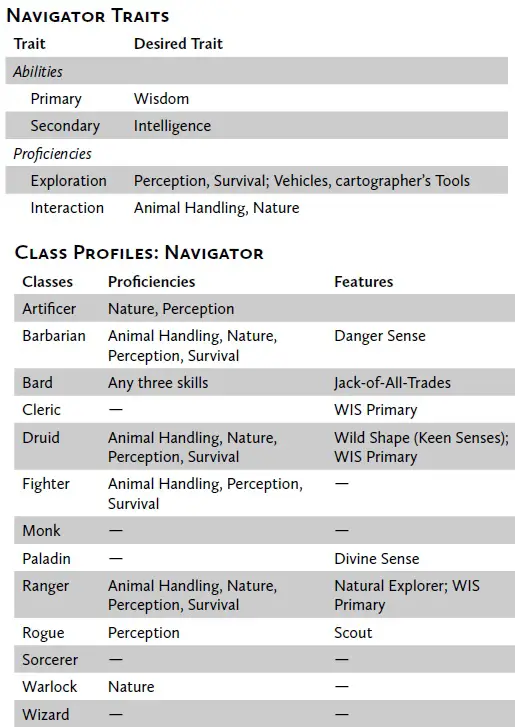
Recommended Class for “The Navigator”: Ranger
Natural Explorer is the strongest navigation feature in the game. It has its issues and lack of use in many scenarios, but you can’t deny the benefits when they come into play are remarkable as a Navigator. I see this feature dogged in long-running, massive-scale campaigns over multiple terrain types. It starts to feel useless once the party secures fast travel or if the group isn’t roleplaying survival aspects. However, this is a relatively strong feature if you’re playing out survival as per the given rules.
If your table doesn’t value Natural Explorer greatly, Scout Rogue would be my recommendation. Survivalist is a free proficiency and expertise with Nature and Survival on top of Rogue’s remarkable class features.
Surprise Star: Barbarian
This seems to be where Barbarian’s real roleplay meat was intended to come in. Since Athletics is the only Strength-based skill, it’s reasonably possible to build a Navigator as a Barbarian that takes advantage of its Danger Sense feature to take the brunt of any traps or surprise attacks it sees coming from the front. With the possibility to gain proficiency with all skills when taken in tandem with specific Backgrounds, the Barbarian can easily take on both the Muscle and Navigator dynamics for your group.
“The Scout” Playstyle
While the Scout Roguish Archetype exists, it isn’t the only means of creating a Scout character dynamic. A Scout is a sensory specialist adept at gathering information through surveillance, be it the location of particular objects, finding creatures, or hidden areas. This dynamic is critical in parties heavy on Buff/Debuffing Supports, as these combat roles get the most out of going early, and the Scout is the dynamic that helps to find the target to surprise.
This dynamic overlaps with Navigator, Dungeoneer, and Sneak, but it prioritizes finding things to deal with instead of dealing with them directly. There are remarkable scouting tools in spells and class features, such as the arcane eye, find familiar, and scrying spells, and Druid’s Wild Shape, meaning this isn’t strictly pinned-down to Dexterity- based characters. Languages are also a nice bump but aren’t absolute necessities. Being able to translate what the kobolds in the next room are saying and figure out where their ambushes and traps are? It’s an excellent way for you Dungeon Masters out there to make what tends to be a forgotten corner of the character sheet pay off.
Famous “Scout” Examples
- Calamity Jane (Deadwood)
- Drizzt Do’Urden (Forgotten Realms)
- Jester Lavorre(Critical Role)
- Keyleth (Critical Role)
- Scanner (X-Men)
- Spook (Mistborn)
- Toph (Avatar: The Last Airbender)
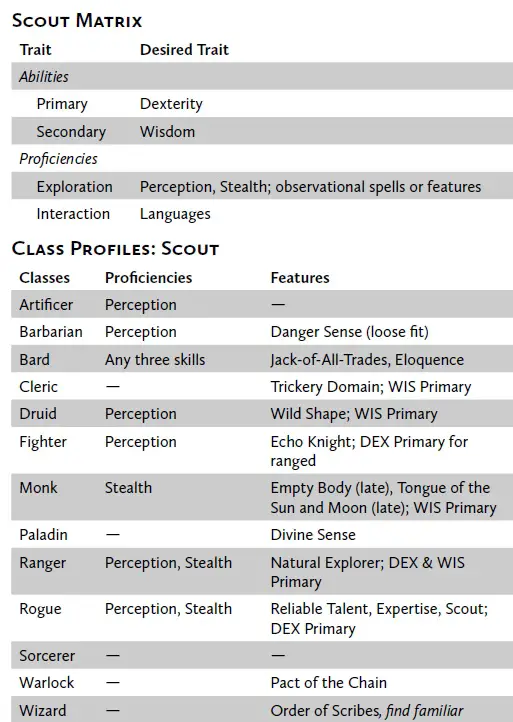
Recommended Class for “The Scout”: Druid
While the Scout might feel like the perfect load-out for this dynamic, you cannot overstate how good Wild Shape is for scoutting in every scenario. The different beasts mean that, although Druids can’t pick up Stealth as a class proficiency, they can most certainly get it through a beast.
Further, the Druid spell list includes spells like Beast Sense, Locate Creature, Locate Object, Scrying, and Speak with Animals. If you’re playing with the variant rules in Tasha’s Cauldron of Everything, you can cast Find Familiar. Druid provides everything this dynamic asks for through a feature that continues to grow with you and provides so much flexibility.
Surprise Star: Fighter – Echo Knight
Once you reach 7th level in this subclass, the Echo you get is an infinitely refreshable, no-risk scouting tool with which you can swap places. It’s one of the core reasons I rate the Echo Knight so high on my ratings table and recommend that the Manifest Echo be tied to a limited number of uses. The Echo Knight doesn’t cause issues during combat, and the range of 1,000 feet is restrictive outside of dungeons, but wow, it outscouts every other character as soon as you start delving.
“The Sneak” Playstyle
Now we have the skulker in the shadows. This character most likely leads to a surprise round. The silent assassin, the scoundrel pickpocket, and the wicked poisoner all rely on going unnoticed to achieve their goals, making them the Sneaks we’re used to seeing in fiction. This dynamic is firmly cemented in fantasy adventuring parties, thanks mainly to Bilbo Baggins. Thorin and Gandalf didn’t pick him up thanks to his fighting prowess, they needed a burglar, and it turns out Hobbits have a great knack for going unnoticed.
Sneaks aren’t tied-down to combat mechanics, though; thanks to Rogue, this dynamic often blends with the Dungeoneer and Scout. Just make sure if you’re playing the Scout dynamic that your party knows before you go from surprise coordination to confirmation.
You want proficiency, Expertise, and advantage on Stealth. You want invisibility if it’s available. If you can get darkvision? Even better for creeping in the shadows, although this tends to be tied behind racial traits or spells. You’re also going to value Perception highly because you can’t Sneak if someone else can get the jump on you. Sleight of Hand is also a fantastic pick-up for pickpockets, and thieves’ tools are perfect for breaking into and out of things.
Famous “Sneak” Examples
- Aguilar de Nerha, Ezio Auditore (Assassin’s Creed)
- Aladdin (Aladdin)
- Arya Stark (Game of Thrones)
- Bilbo Baggins (Lord of the Rings)
- Genji (Overwatch)
- Locke Lamora (Gentleman Bastards Sequence)
- Psiren (Full Metal Alchemist)
- Snake (Metal Gear Solid)
- Spy (Team Fortress 2)
- Yuffie Kisaragi (Final Fantasy VII)
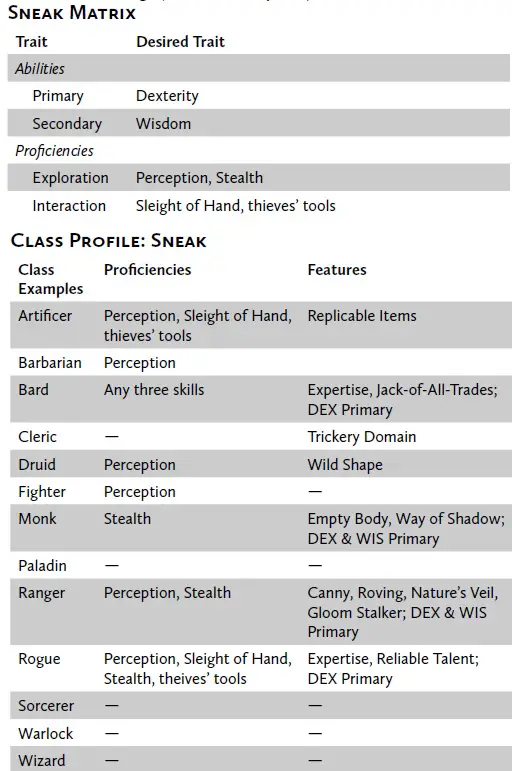
Recommended Class for “The Sneak”: Rogue
Duh. Rogue is famous for being sneaky!
Surprise Star: Ranger (Gloom Stalker)
This subclass, especially after Tasha’s Cauldron of Everything, does everything magical you’d want from the Sneak; it just lacks the mechanics to gain Expertise or advantage. It’s possible through Feats to get some of that kit, but Rogue getting so much of it just through the class itself keeps Gloom Stalker right under it. I’m sure most people think “rightly so.” Maybe if the 5e Rogue got some help in darkness this wouldn’t be so close of a call. I expected Way of Shadow Monk to wind up close to the top, but I always forget this subclass has to blow two freaking ki points to get its darkvision. In any case, Gloom Stalker Ranger does get access to spells and skills that make it look like a desirable Sneak option.
“The Supplier” Playstyle
Another dynamic I’ve mentioned on my channel was the Supplier, a character that can guarantee the group access to magic items and equipment while they’re away from a major settlement. The only ways to do this are to play Artificer, College of Creation Bard, or Forge Domain Cleric at the moment, so I’m opting to mention those here instead of doing a whole breakdown of the dynamic. If you’re interested in checking out what it means to be a supplier, you can pick up the Merchant class I designed for free over the Dungeon Masters Guild.
For vanilla D&D, check out the crafting rules and the classes I mentioned earlier. Speak with your DM about what would be suitable for the table if you’re interested in this dynamic.
Closing
Playstyles are important for GMs and players alike to understand. Knowledge of playstyles will enable everyone to discover like-minded people to maximize the fun of the game.
I hope this was an entertaining breakdown of this concept. If you like what I do, you can check me out on Patreon and YouTube! “Indestructoboy” on both.
Massive shout-out to my Patreon Sponsors for allowing me to make fun content like this. You all are absolute heroes. Everyone stay safe, stay healthy, and I’ll see you in the next one.

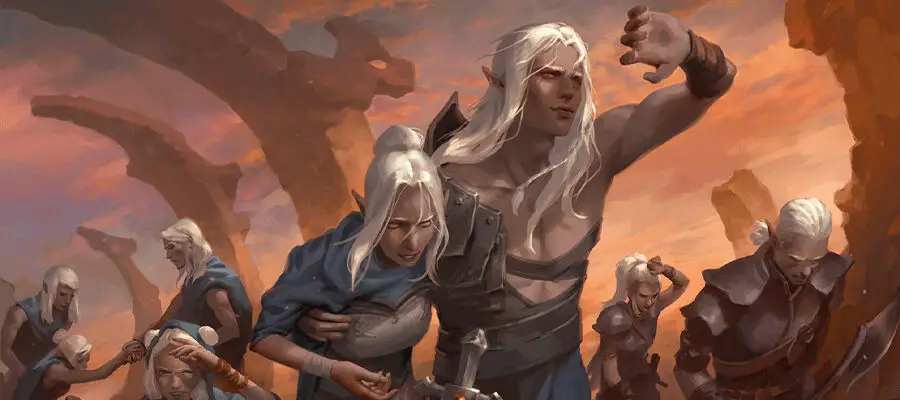


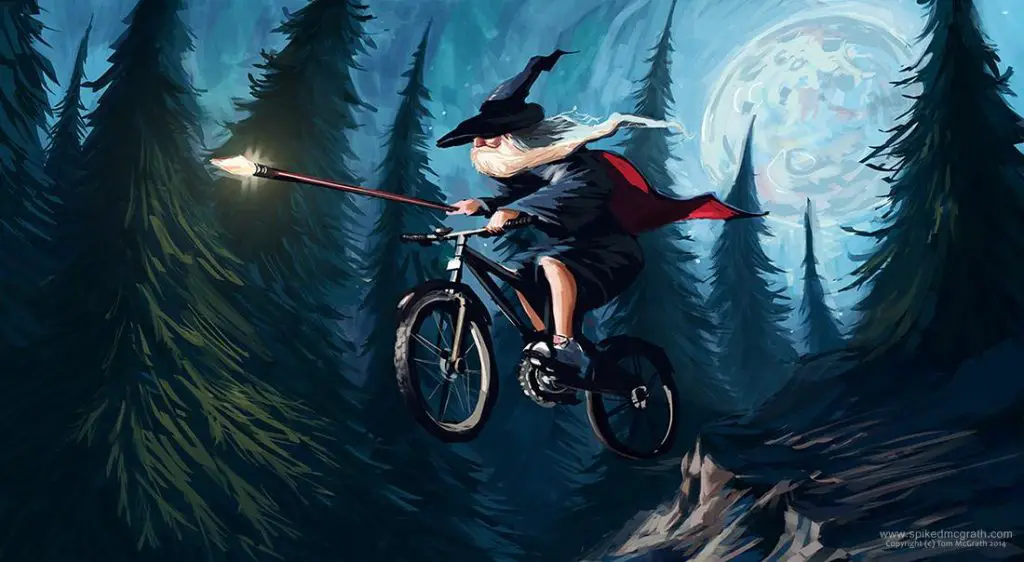
There’s a playstyle you missed. It’s sort of like muscle, but not belligerent. It’s got a bit of the keeper, but it’s not a healing type. It’s a get-shit-done type, but it’s not the navigator or scout. It’s built upon quiet power, which only shows itself when an obstacle needs to be cleared. Call it the fixer, maybe, or the initiator—the one who decides when it’s time to stop talking and act. The one who Makes It So.
Hi Keith! Taron (author) took an atypical approach with this article, pairing playstyles with game mechanics. The muscle, as you explained, is certainly a playstyle, though it’s difficult to tie it to mechanical choices in the game as was the focus of this piece. The initiator/muscle/fixer playstyle could be expressed by players regardless of character choices. If you have suggestions for how the muscle could be tied to mechanical choices (skills, subclasses, etc.), we’d be eager to hear your ideas!